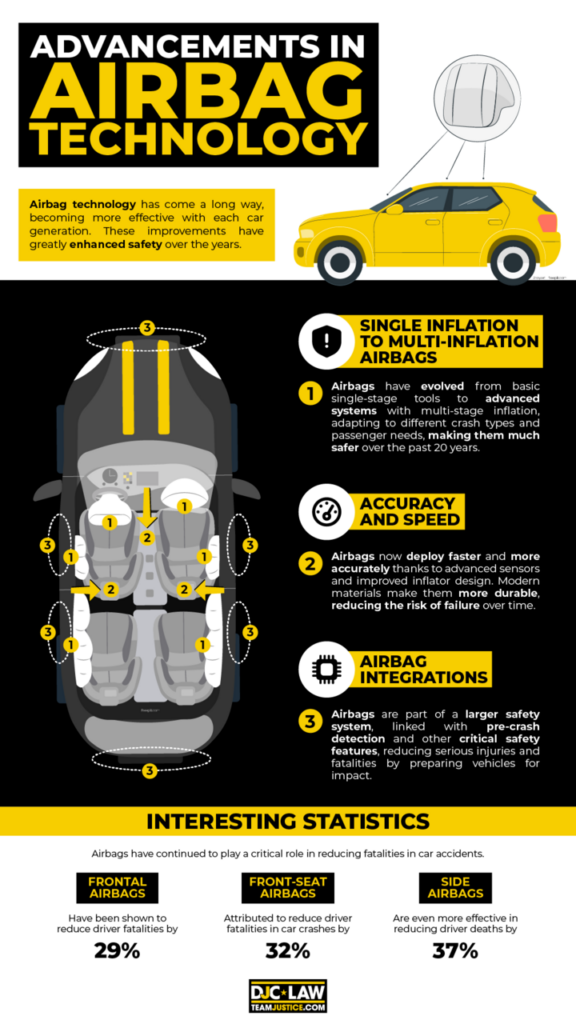
Airbags are one of the single most important safety innovations in history. When deployed, they prevent drivers from striking the steering wheel or dashboard, potentially averting catastrophic injuries.
Did you know that airbags have saved over 50,000 lives in the last 30 years? However, airbags can also cause head and neck injuries, which is why their deployment speed must be set appropriately.
In this guide, we discuss everything you must know about air bag deployment speed, why airbags are essential, and airbag lawsuits.
Key Takeaways
- Airbags deploy within 20 to 30 milliseconds of a collision at rates of around 200 mph.
- Collision severity influences whether an airbag deploys. Generally, they’ll deploy after a collision with a solid, fixed barrier when going at 8-14 mph.
- The effectiveness of airbags can be influenced by several factors, including whether you’re wearing your seatbelt and displaying responsible driving behaviors.
- Your airbag relies on a network of sensors, pyrotechnic initiators, and chemical reactions to activate and inflate in time to prevent serious injury.
- Faulty airbags occasionally fail to deploy or deploy when they shouldn’t, which could result in injury. Speak to a legal professional if this happens to you.
At What Speed Does an Airbag Deploy in an Accident?
Airbags must deploy quickly enough to prevent impact with hard surfaces. On average, an airbag deploys within 20 to 30 milliseconds of a vehicle’s sensors detecting a collision. The airbag then deploys at speeds of around 200 mph until it reaches between 12 and 18 inches.
However, it’s vital to mention that whether your airbag deploys at all depends on several factors, including:
- Collision speed.
- The angle of the impact.
- How much force is produced.
Car manufacturers constantly upgrade airbag deployment to improve the safety of their vehicles. Over the years, airbags have been finetuned to be more effective than at any other point in history.
How Fast Do Airbags Deploy in Seconds?
Airbags deploy in less than a single second. Today, modern vehicles see airbag deployment speeds of 20 to 30 milliseconds. Some models may even deploy airbags faster, with 15 milliseconds becoming the standard in the newest vehicles.
Why airbags deploy so quickly is that to be effective, they essentially have to win a race between the driver/passenger moving due to an impact and the ability to deploy fully and prevent catastrophic bodily damage from occurring.
How Serious Does a Collision Have to Be for Airbags?
Airbags can deploy even at lower speeds. Generally, frontal airbags will deploy when a vehicle hits a solid, fixed barrier between eight and 14 mph. This is also the equivalent of hitting a similar-sized parked car at between 16 and 28 mph.
It may surprise you that it’s this low, but even low-speed collisions can result in injuries, and even occupant ejection for the front seat passenger or rear seat occupant. Some vehicles even alter their deployment speeds based on the presence of safety belts. For example, airbags might deploy if an occupant isn’t using a seatbelt at 10-12 miles per hour.
Are There Instances Where Airbags Fail to Deploy Quickly Enough?
Airbags are an essential part of driver safety, meaning that if an airbag doesn’t deploy quickly enough, that model cannot be legally sold. Instances where airbags haven’t deployed quickly enough are usually due to the airbag being faulty or the vehicle being a much older model.
However, airbags aren’t designed to deploy in every situation. Airbag deployment is extremely fast, meaning that they can cause injuries. Generally, airbags should only be deployed when absolutely necessary.
So, why might an airbag not deploy at all?
- Crash conditions don’t necessitate deploying an airbag because the presence of a seat belt is enough to protect occupants.
- Most modern cars switch off the airbag if the vehicle detects a child or a small-stature passenger in the seat, such as through a safety belt sensor or a child safety seat, or even booster seats. The same goes for some side airbags.
- In used vehicles, the airbag might not have been replaced after a previous crash. All airbags should be replaced after being deployed.
How Does an Airbag Work?
Airbags rely on an advanced network of sensors to detect what’s happening inside and outside the vehicle. If the correct parameters are met, an airbag will deploy using pyrotechnic indicators and a chemical reaction.
The process starts with the sensors placed throughout the vehicle. These are the eyes and ears of an airbag system. Over the years, advancements in sensor technology have resulted in fewer false deployments and faster deployments. Here are some of the things these sensors detect:
- Sudden changes in speed.
- Sudden deceleration.
- Impact forces and force exertion.
These sensors are connected to the airbag control unit. If a sensor detects an issue, it produces a signal to deploy the airbag. The airbag control unit is responsible for setting off a small pyrotechnic initiator.
Initiators are essentially small explosives, which is why you’ll hear a bang when an airbag is deployed. They’re also responsible for generating gas that ignites the solid chemicals within. Many airbags use sodium azide. When these solids burn away, they produce nitrogen, which fills the airbag. All of this happens in milliseconds.
Once deployed, the corresponding airbag will be deployed, whether that’s in your steering wheel, dashboard, or side doors. The airbag expands to a maximum range of 18 inches, cushioning the blow when the driver/passenger hits it.
Airbags aren’t silver bullets, but they can prevent serious injuries by absorbing the energy from a vehicle’s occupants, as opposed to a hard surface absorbing that energy.
Advancements in Airbag Technology

Airbag technology has improved over the years, making these life-saving devices more effective than ever before. Most airbag improvements have been incremental. As cars have modernized and generations of autos have passed, airbags have evolved alongside them.
Let’s focus on three aspects of airbags that have been critical to saving lives.
Single Inflation to Multi-Inflation Airbags
Initially, airbags were basic tools deployed with only one inflation stage whenever a car experienced frontal crashes. Today’s airbag systems use multi-stage inflation systems based around frontal collisions, rollover crashes, and side crashes.
It’s this evolution that enables them to adjust speed and pressure depending on the characteristics of those in the car and the severity of collisions. This is also why airbags have become safer in the last twenty years.
Accuracy and Speed
One of the great challenges was ensuring that airbags deployed faster and with greater accuracy. Engineers have improved the sensor technology behind airbags and the design of the inflators themselves.
Today, airbags are about as close to an instant response as we’re likely to get. Likewise, the materials we use in airbags have changed, so they’re more durable and less likely to fail due to wear and tear.
Airbag Integrations
Many people think airbags are an individual system found in cars, but that’s far from the truth. Airbags form part of an entire safety ecosystem. Engineers have connected them with other critical safety systems, including pre-crash systems for detecting potential collisions and preparing motor vehicles for an upcoming impact.
These integrations have been instrumental in minimizing injury risk and maximizing safety, helping to slash the number of serious injuries and fatalities on America’s roads.
Common Misconceptions About Airbag Deployment Speed
Drivers today still hold a range of misconceptions regarding how fast airbags typically deploy. Here’s a rundown of the most common myths about airbags.
Do airbags deploy instantly when a crash happens?
No, because airbags rely on sensors detecting what’s going on, sending those signals to the control system, and then initiating a reaction. It actually takes a few milliseconds for airbags to deploy. Using the naked eye, this can be misconstrued that they inflate instantly.
Can Airbags Deploy Too Early or Late?
In the distant past, airbags could deploy at the wrong time because the technology was primitive compared to today. Auto manufacturers have changed that, and now airbag systems are designed to deploy fast enough to provide protection without deploying too early and causing premature inflation injuries.
Are Airbags Really That Effective at Preventing Injury?
Some people have questioned whether airbags cause more harm than good because of premature inflation injuries in the past. However, countless studies have demonstrated that airbags reduce injury risk and severity by a massive amount.
Airbags provide a cushion between you and the hard surface in front of you. They absorb most of the impact and distribute forces evenly, thus preventing serious injury. No airbag will prevent all injuries in a severe crash, but they can mean the difference between a short hospital stay and being confined to a wheelchair.
What’s the Role of Driver Behavior in Airbag Effectiveness?
Driver behavior also impacts how effective an airbag is at preventing serious injury. How a driver performs on the road and whether they drive safely will increase or decrease the effectiveness of airbags.
Here are the three primary behavioral factors to think about:
- Seat Belt Use – Wearing a seat belt confines you securely to your seat. In car accidents, seatbelts stop you from being thrown forward. Unbelted occupants are thrown forward further, which could increase the risk of an airbag injury.
- Safe Driving – It goes without saying that the best way to prevent injury is to avoid situations where an airbag would need to be deployed in the first place. Defensive driving tactics reduce your reliance on airbags, making you less likely to suffer an injury. Strategies include keeping both hands on the steering wheel and obeying the rules of the road.
- Behavioral Trends – It’s a proven fact that more injuries relating to airbags happen when drivers engage in behaviors like distracted driving or driving aggressively. Regardless of airbag deployment, there’s no question irresponsible driving increases the risk of a serious collision.
What are Some Common Airbag Injuries?
Airbags prevent serious injury, but in some circumstances, they can cause injury. Faulty airbags or occupants not wearing seat belts are among some of the risk factors for an airbag-related injury.
Here’s a shortlist of some of the most common airbag injuries:
- Abrasions
- Burns
- Contusions
- Bruises
- Facial injuries
- Chest injuries
- Hearing loss
- Neck injuries
- Spinal injuries
- Head injuries
Of course, these injuries don’t have to be a bad thing if they save you from something catastrophic. Airbags aren’t feather pillows. They’re there to potentially save your life.
Insurance Implications of Airbag Deployment
Airbag deployment matters when making an auto insurance claim because it demonstrates you were in a moderate to severe car accident. Adjusters will check airbag records when determining compensation, and deployment records are vital evidence in car accident reconstructions.
How Airbag Deployment Affects Insurance Claims
Airbag deployment influences insurance claims because it’s irrefutable evidence that you were involved in a moderate to severe collision. In the past, Chicago personal injury lawyers have used these records to fight back against denials of claims.
Plus, evidence of airbag deployment can prove that someone has the injuries they claim they do. This is especially true when victims have pre-existing conditions that adjusters argue were there before the crash.
Proving that a collision led to airbag deployment could mean getting a larger settlement and also ensuring you get the compensation that matches your injuries.
Understanding Deductibles and Payouts Post-Airbag Deployment
Airbag deployment requires replacing said airbag. This could enable you to get a larger payout because the cost of repairing your car may then be more than the car is worth, leading to it being totaled.
However, deductibles still come into play regardless of airbag deployment. For example, let’s say that your car is worth $7,000 and your deductible is $500. Your insurance company would pay you $6,500.
It must be noted that airbag deployment alone doesn’t define whether a car is totaled or provides you with extra compensation. Airbag deployment is a factor in determining a settlement rather than the pivot.
The Role of Airbag Records in Car Accident Reconstruction
Accident reconstruction is a science relying on an array of evidence. If an airbag is deployed, reconstructionists will seek out these records to help them reconstruct the accident accurately.
Reconstructionists download the airbag module and then extract the data indicating what happened seconds before the vehicle experienced a collision. This provides vital data, including the speed of the vehicle and whether the brakes were activated.
Again, airbag records are merely a factor in rebuilding the scene. They’re usually not the pivotal factor in an accurate reconstruction, as data is drawn from other vehicle modules, driver statements, and eyewitness accounts.
How Common are Airbag Lawsuits?
Airbag lawsuits aren’t as common as you think because you must prove the airbag was faulty and shouldn’t have been deployed in the first place. If you suffered an airbag-related injury, the automatic assumption is that it prevented you from suffering a more serious injury. However, airbag lawsuits do happen and are often accompanied by recalls.
Typical Scenarios Leading to Airbag Lawsuits
Receiving compensation for an airbag injury requires that you prove it was defective. For example, if an airbag fails to deploy at all, you could be entitled to compensation. Likewise, if an airbag is deployed when it shouldn’t have, this could also give rise to liability.
Typically, we have three types of defects that may enable you to file a product liability lawsuit:
- Manufacturing Defect – A properly designed airbag was manufactured incorrectly, leading to premature wear and tear, or it left the facility in sub-par condition.
- Design Defect – The airbag was poorly designed, meaning it was destined to perform below standards from the start.
- Failure to Warn Defect – All manufacturers must provide reasonable warning regarding the potential dangers of their airbags. If this information wasn’t available, it could give rise to liability.
With the manufacturing standards in place these days, defects aren’t massively common, hence why successful airbag lawsuits aren’t as common as they used to be.
Legal Outcomes of High-Profile Airbag Cases
Airbag cases do happen every so often. Perhaps the most notorious airbag lawsuit involved the Takata Corporation.
The lawsuit against the Takata Corporation in 2013 was the biggest auto recall in history, resulting in 67 million airbags being recalled. It’s believed these airbags resulted in 180 injuries and 18 deaths because Takata used ammonium nitrate instead of nitrogen gas to inflate their airbags.
The problem is that ammonium nitrate breaks down and becomes unstable when exposed to moisture without a drying agent. Takata’s airbags didn’t contain this drying agent, resulting in improper inflation and metal shrapnel flying through passenger vehicles.
It resulted in several individual and class action lawsuits not only in the U.S. but overseas. For example, Takata was forced into a $52 million in New South Wales, Australia.
What to Do When You Suffer Injuries Due to an Airbag that Fails to Deploy?
Faulty airbags represent a serious threat to drivers and front seat passengers. In the past, fatalities have been caused by faulty airbags. If an airbag fails to deploy when it should have, you could be entitled to compensation.
But what should you do if your airbag fails to deploy and you suffer significant injuries as a result?
Immediate Steps to Take Following an Incident
Prioritize your health and safety after car accidents. This means getting out of harm’s way, if possible, and checking yourself for injuries. You should also call 911 and ask for a police officer to attend. If your injuries are significant, call for an ambulance.
Remember, you may feel fine while the adrenaline courses through your veins, but that doesn’t mean you’re okay. Some injuries can worsen over time or even take time to emerge. That’s why your first destination after an accident should be the emergency room.
Gathering Evidence for Potential Legal Action
Evidence is most effective when it’s fresh. Drivers and passengers who feel physically able should gather as much of it as possible.
Actions you can take include:
- Photographing each vehicle.
- Photographing your injuries.
- Taking eyewitness statements, including contact details.
- Recording the road conditions.
- Recording any visible road signs.
Preserve all available evidence. Until you speak to an attorney, don’t have your car sent to the repair shop or junkyard. Leave everything as it is.
Consulting With a Personal Injury Lawyer
Product liability lawsuits are some of the most complex cases in the legal profession. You need expert Chicago personal injury lawyers to assess the situation and file a claim on your behalf.
Attorneys are there to evaluate the merits of your case, educate you on your legal rights, and navigate the legal minefield. Ultimately, it’s your personal injury attorney who will not only increase your chances of winning but also increase the size of any settlement due.


